Q1. Which of the following is the cofactor of carbonic anhydrase?
Solution
Carbonic anhydrase is a zinc-activated enzyme, so its cofactor is zinc.
Q2. Haemoglobin
is a
Solution
Haemoglobin
is a respiratory pigment which binds with oxygen to form oxyhaemoglobin and
is then transported to various body cells for respiration.
Q3. The vital capacity of the lungs includes
Solution
The vital capacity is the total of the tidal volume, inspiratory reserve volume and expiratory reserve volume.
Q4. What is the average breathing rate in a healthy human?
Solution
The average breathing rate in a healthy human is 12-16 times per
minute.
Q5. It is known that exposure to carbon monoxide is harmful to animals because
Solution
Carbon monoxide is harmful to animals because it combines more readily with haemoglobin than oxygen forming the stable compound carboxyhaemoglobin and thus destroys free haemoglobin.
Q6. Name the muscles present between the ribs which generate the pressure
gradients in lungs.
Solution
External and internal intercostal muscles
Q7. In Hamburger’s phenomena, which ion is transported?
Solution
The movement of chloride ions is called the chloride
shift or Hamburger phenomenon. Chloride ions diffuse from the plasma into the
erythrocytes to restore the ionic balance when the bicarbonate ions are
transported during carbon dioxide transport.
Q8. State the two stages involved in breathing. Name the components which
help in adjusting the volume of the thoracic chamber.
Solution
Two stages involved in breathing are
Inspiration:
Atmospheric air is drawn inside the body.
Expiration:
Alveolar air is released out of the body.
The diaphragm and internal and external intercostal muscles help in
adjusting the volume of the thoracic chamber.
Q9. Name the three layers which constitute the diffusion membrane.
Solution
The three layers of the diffusion membrane are
Thin
squamous epithelium of alveoli
Endothelium
of alveolar capillaries
Basement
membrane or substance present between the squamous epithelium of alveoli
and the endothelium of alveolar capillaries
Q10. Mosquito receives air through
Solution
The mosquito receives air through spiracles which enters the trachea and transports the respiratory gases into the body cells.
Q11. Name the two blood vessels which recognise the changes in H+
ions and CO2.
Solution
Aortic arch and carotid artery
Q12. Respiratory quotient is defined as
Solution
Respiratory quotient is defined as the ratio of the volume of carbon dioxide produced to the volume of oxygen consumed over a period of time in respiration.
Q13. In breathing movements, the air volume can be estimated by
Solution
A spirometer is an instrument used for recording the changes in the volume of air in and out of the lungs. This process is called spirometry.
Q14. Alveoli become enlarged and damaged with reduced surface area in heavy smokers. The condition is called
Solution
In Emphysema, over inflation of the alveoli and rupture of alveolar walls occur. This decreases the surface area and pulmonary ventilation.
Q15. How much percent of CO2 is present in
expired air?
Solution
3.6% of CO2 is present in
expired air when the partial pressure is 32 mm Hg.
Q16. The amount of volume of air which can be inspired/expired normally is called
Solution
Tidal volume is the volume of air normally inspired or expired in one breath without any effort. It is about 500 ml in the average human adult male.
Q17. RQ of fat is
Solution
The ratio of the volume of carbon
dioxide produced to the volume of oxygen used in a unit time is called
respiratory quotient (RQ). The fats are hydrolysed to glycerol and fatty
acids. The fatty acids are poor in oxygen, so they require more oxygen for
their complete oxidation. Therefore, the absorption of oxygen is more than the
liberation of carbon dioxide, and thus, RQ becomes less than unity.
Q18. The oxygen
dissociation curve is
Solution
An
oxygen dissociation curve is the graph showing the percent saturation of haemoglobin
with the changes in partial pressure of oxygen at constant pH. The curve
shows that there is a progressive increase in the percent saturation of haemoglobin
with the increase in partial pressure of oxygen up to a level, and then it
becomes constant. So, a normal oxygen dissociation curve is sigmoid.
Q19. Name the part of the CNS which regulates the functions of the
respiratory rhythm centre.
Solution
Pneumotaxic centre
Q20. The term ‘Glycolysis’ has originated from the Greek words
Solution
The term ‘Glycolysis’
has originated from the Greek words ‘glycos’
and ‘lysis’. ‘Glycos’ means sugar and ‘lysis’ means
splitting.
Q21. Name the process by which oxygen is taken in and carbon dioxide is
released into the atmosphere.
Solution
Pulmonary ventilation (breathing)
Q22. The
alveoli of lungs are lined by
Solution
Squamous epithelium forms the
delicate lining of cavities such as the alveoli of lungs, mouth, pericardium,
oesophagus and nose. It is made of thin, flat, irregular shaped cells which
fit together like floor tiles to form compact tissues.
Q23. What is tidal volume?
Solution
Tidal volume is the volume of air inspired or expired during normal
respiration.
Q24. Increased
asthmatic attacks in certain seasons are related to
Solution
Increased
asthmatic attacks in certain seasons are related to inhalation of pollen
grains of plants (e.g. congress plant). Asthma is characterised by narrowing
and inflammation of bronchi, bronchospasm and difficulty in breathing.
Q25. In humans, which among these is not a step in respiration?
Solution
In humans, respiration involves the following steps:
Pulmonary ventilation
Alveolar diffusion of O2 and CO2
Transport of gases by blood
Diffusion of O2 and CO2 between blood and tissues
Utilisation of O2 by cells for catabolic reactions and the resultant release of CO2
Q26. Respiration results in
Solution
Respiration is a catabolic process which involves
uptake of oxygen by tissue cells, oxidation of food by oxidising enzymes
inside the cells and release of carbon dioxide from body tissues.
Q27. A is using maximum capacity to inhale as well as to exhale. What is
the term which can be used for the volume of air exhaled by A.
Solution
Vital capacity
Q28. What is true about haemoglobin?
Solution
Haemoglobin is formed of four iron-containing porphyrin prosthetic groups attached to a globin protein. Each porphyrin molecule is formed at four pyrrole rings attached to iron element at the centre.
Q29. The total number of alveoli in both lungs are
Solution
There are about 300 million alveoli in both the
lungs which increase the surface area for the exchange of respiratory gases.
Q30. Binding of oxygen with haemoglobin tends to displace carbon dioxide from the blood. This phenomenon is called
Solution
Binding of oxygen with haemoglobin tends to displace carbon dioxide from the blood. This phenomenon is called Haldane effect. It occurs because the combination of oxygen with haemoglobin causes it to become a stronger acid which, in turn, displaces carbon dioxide from the blood.
Q31. Severe acute respiratory syndrome (SARS)
Solution
Severe acute respiratory syndrome (SARS) is caused by human coronavirus. It spreads through contact, respiratory secretions and cockroaches. The main symptoms include cold, dry cough, headache, loss of appetite and fever.
Q32. What is partial pressure? What are the symbols used to denote the
partial pressures of oxygen and carbon dioxide?
Solution
Partial pressure is the pressure contributed by the individual gas in
a mixture of gases.
Symbols used to denote the partial pressure of oxygen and carbon
dioxide are pO2 and pCO2.
Q33. Dead space air in man is
Solution
Of 500 ml of inspired air, only 350 ml of fresh air reaches the lung alveoli and is called alveolar volume while about 150 ml of inspired air remains in the respiratory tract which is called anatomical dead space volume.
Q34. The chloride shift occurs in response to
Solution
The chloride shift occurs in response to bicarbonate ions (HCO3−). Most of the bicarbonate ions diffuse into the plasma of the blood during the transport of carbon dioxide. To restore the ionic balance, equal amounts of chloride ions diffuse inside the RBCs from the plasma. The exchange of bicarbonate ions of RBCs and chloride ions of the plasma is called the chloride shift or Hamburger shift.
Q35. Hamburger shift is also known as
Solution
The exchange of bicarbonate ions of RBCs and chloride ions of plasma is called the Hamburger shift or chloride shift.
Q36. The majority
of carbon dioxide produced by our body cells is transported to the lungs
Solution
About 70% of carbon dioxide is transported from the
body tissues to the lungs as sodium and potassium bicarbonates.
Q37. Which one of the following mammalian cells is not capable of metabolising glucose to carbon dioxide aerobically?
Solution
Red blood cells are not capable of metabolising glucose to carbon dioxide aerobically because they lack mitochondria which are the sites of aerobic respiration.
Q38. Book lungs are respiratory organs of
Solution
Arachnida are Arthropods which have jointed legs. These include spiders, scorpions, ticks and mites. The respiratory organs of Arachnida are book lungs.
Q39. Represent the human respiratory system diagrammatically.
Solution
Human respiratory system:
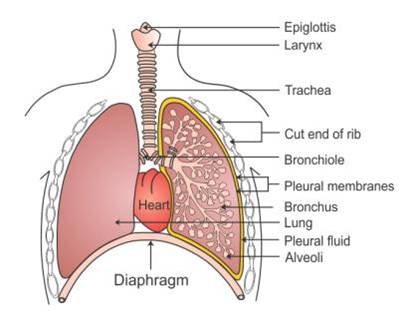

Q40. Name the kind of volume the following components constitute:
TV
+ IRV
RV
+ ERV + TV + IRV
TV
+ ERV
ERV
+ RV
Solution
TV
+ IRV - Inspiratory capacity (IC)
RV
+ ERV + TV + IRV - Total lung capacity
TV
+ ERV - Expiratory capacity
ERV
+ RV - Functional residual capacity
Q41. The breathing rate in humans is
controlled by
Solution
The breathing rate in human is controlled by the medulla
oblongata in which inspiratory and expiratory centres are located.
The inspiratory
centre or dorsal respiratory group (DRG) causes inspiration.
The expiratory
centre or ventral respiratory group (VRG) causes either inspiration or
expiration depending on which neurons in the group are stimulated.
Q42. The enzyme essential for the transport of CO2 as bicarbonate in the blood is
Solution
Carbonic anhydrase is an essential enzyme used for the transport of CO2 as bicarbonate in the blood. It is stimulated by the low partial pressure of oxygen at the cellular level.
Q43. Write the effects of the following disorders on the human body:
Asthma
Emphysema
Solution
Asthma - Difficulty in breathing, inflammation of bronchi and bronchioles
Emphysema - Alveolar walls get damaged reducing the respiratory surface
Q44. The bulk of CO2 released from body fluids into the blood is present as
Solution
About 70% of carbon dioxide released by respiring tissue cells diffuses into the plasma and then into red blood cells, where it combines with water to form carbonic acid.
Q45. About 97% of O2 is
transported by RBCs. The remaining 3%
Solution
About 1-3% of oxygen is transported by the blood in the
dissolved form in blood plasma.
Q46. Oxygen-carrying capacity
of human blood is reduced due to the pollution of
Solution
The oxygen-carrying
capacity of human blood is reduced due to carbon monoxide poisoning. CO
combines more readily with haemoglobin than oxygen, forming a stable compound,
carboxyhaemoglobin, which reduces the amount of free haemoglobin available
for carrying oxygen.
Q47. The pharynx opens into the larynx by a slit-like aperture called
Solution
The pharynx opens into the larynx by a slit-like aperture called the glottis, which is covered by a cartilaginous flap called the epiglottis. The epiglottis closes the glottis to prevent the entry of food particles during swallowing.
Q48. Oxygen is carried by
Solution
Erythrocytes or RBCs are capable of binding oxygen
as it has a haemoglobin pigment which contains a haem part and a protein part
in its structure. The haem part of the haemoglobin
structure contains four atoms of iron, each capable of combining with a
molecule of oxygen. Oxygen combines with haemoglobin to form oxyhaemoglobin
and is carried to different body cells.
Q49. Explain diagrammatically the mechanism of breathing and the positions of ribs, diaphragms and the thoracic cavity during inspiration and expiration.
Solution
Mechanism of breathing - inspiration:
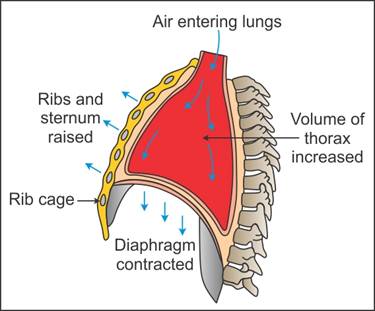 Mechanism of breathing - expiration:
Mechanism of breathing - expiration:
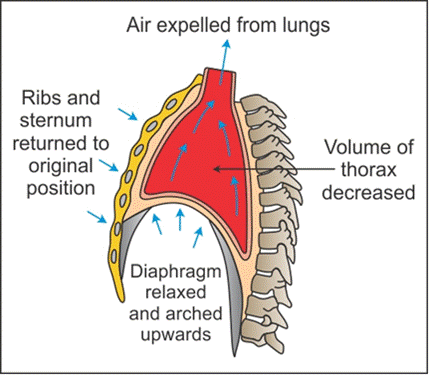
 Mechanism of breathing - expiration:
Mechanism of breathing - expiration:

Q50. State the name of the form in which CO2 is transported by
blood.
Solution
Carbaminohaemoglobin
Q51. State the significance of the sigmoid oxygen dissociation curve.
Solution
The sigmoid oxygen dissociation curve is useful in studying the
effects of factors such as H+ ion concentration and pCO2
on binding of oxygen with haemoglobin.
Q52. The partial pressure of oxygen in the lungs is
Solution
The partial pressure of oxygen
in the lungs or alveolar air is approximately 100 mm Hg, while that of oxygen
in the venous blood in pulmonary arterial capillaries is 40 mm Hg on an average. Due to a PO2 difference
between air and blood, oxygen diffuses rapidly from the alveolar air into the
blood.
Q53. The lungs are enclosed in a covering called
Solution
Each lung is enclosed by a thin, transparent,
two-layered membrane called the pleural membrane. The inner membrane is
called visceral pleuron and the outer membrane is called parietal pleuron.
Between these two membranes, a cavity called the pleural cavity is present
which is filled with a watery fluid called the pleural fluid.
Q54. Name one disorder caused by cigarette smoking.
Solution
Emphysema
Q55. Which part of the human respiratory system serves as the common
passage for food and air?
Solution
Nasopharynx
Q56. Name the instrument used to measure pulmonary volume.
Solution
Spirometer
Q57. In which parts of the central nervous system is the respiratory rhythm
centre located?
Solution
Medulla oblongata
Q58. The respiratory centre of the brain is sensitive to
Solution
An increase in the carbon dioxide concentration in the blood stimulates the inspiratory and expiratory centres through increased formation and dissociation of carbonic acid and increased concentration of H+, which lowers the pH of blood and results in acidosis.
Q59. After deep
inspiration, maximum expiration of lungs is called
Solution
The maximum volume of air a person can
breathe in after a forced expiration or the maximum volume of air a person
can breathe out after a forced inspiration is called vital capacity.
Q60. Identify the following structures of the human respiratory system:
Double membrane which covers the lungs
Sac-like structures which are in close contact with the capillary network
Structure which helps in producing sound
Region where the nasopharynx opens through the glottis
Solution
Double membrane which covers the lungs - Pleura
Sac-like structures which are in close contact with the capillary network - Alveoli
Structure which helps in producing sound - Larynx
Region where the nasopharynx opens through the glottis - Trachea
Q61. The pneumotaxic centre is present in
Solution
The pneumotaxic centre is present in the dorsal part of pons varolii. Its main function is to limit inspiration.
Q62. 1200 ml volume of air which always remains in the lungs even after forcible expiration is called
Solution
Residual volume is the volume of air which always remains in the lungs even after forcible expiration. It is about 1100-1200 ml.
Q63. Name the process used by comb jellies for the exchange of gases during
respiration.
Solution
Diffusion
Q64. A person breathes in some volume of air by forced inspiration after having a forced expiration. This quantity of air taken in is
Solution
A person breathes in some volume of air by forced inspiration after having a forced expiration. This quantity of air taken in is the total lung capacity. It is equal to the sum of the vital capacity and the residual volume.
Q65. Which one of the following can bind several hundred times more strongly to the haemoglobin than oxygen?
Solution
CO (carbon monoxide) can bind several hundred times more strongly to haemoglobin than oxygen forming the stable compound carboxyhaemoglobin. This reduces the amount of free haemoglobin available for carrying O2.
Q66. Residual volume is
Solution
Residual volume is always greater than tidal volume. Tidal volume is the
volume of air normally inspired or expired in one breath without any effort,
and the residual volume of air is the air which remains in the lungs even
after forcible expiration. Tidal volume is about 500 ml, whereas residual
volume is about 1100-1200 ml.
Q67. During hibernation, the frog respires through
Solution
During hibernation, cutaneous respiration occurs in the frog, i.e. it respires through its moist skin or integument. The skin is permeable to respiratory gases and carries oxygen to the body cells for respiration.
Q68. Represent diagrammatically the exchange of gases at the alveolar level and the tissue level.
Solution
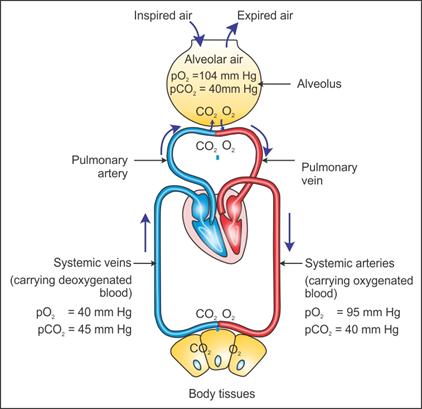
Q69. In which of the following animals, respiration occurs without any respiratory organ?
Solution
The earthworm breathes through its thin and moist skin.
Oxygen is absorbed and transported to all the cells of the body where it is utilised for respiration.
Q70. The volume of air which remains in the
conducting airways and is not available for gas exchange is called
Solution
The volume of air
which remains in the conducting airways and is not available for gas exchange
is called anatomic dead space. It is approximately 150 ml.
Q71. Name the region present in the central nervous system which regulates
respiration.
Solution
Respiratory rhythm centre
Q72. Distinguish between IRV and ERV.
Solution
IRV (Inspiratory Reserve Volume)
ERV (Expiratory Reserve Volume)
It is the additional volume of air which a person can inhale during forcible inspiration.
It is the additional volume of air which a person expires during forcible expiration.
It averages 2500 to 3000 ml.
It averages 1000 to 1100 ml.
Q73. Name the enzyme which is present in high quantities in RBCs.
Solution
Carbonic anhydrase
Q74. Name the following:
Volume
of air which remains in the lungs after normal expiration
Total
volume of air a person can inspire after normal expiration
Solution
Volume
of air which remains in the lungs after normal expiration - Inspiratory
capacity (IC)
Total
volume of air a person can inspire after normal expiration - Functional
residual capacity (FRC)
Q75. In the kidneys, a blood vessel has pCO2 = 45 mm Hg, which
is lower than the kidney tissues. What will be the direction of the diffusion
of blood?
Solution
The direction of diffusion of blood will be from the kidney tissue to
the blood vessel.
Q76. Regarding the functions of our respiratory system, mark the wrong entry.
Solution
Nasal chambers help in moistening or humidifying the air with evaporated mucous. It also helps in warming up the air by heat radiated by the blood. Diffusion of respiratory gases also occurs by the respiratory system.
Q77. One molecule
of haemoglobin carries how many molecules of oxygen?
Solution
One molecule of haemoglobin
carries four molecules of oxygen. The haem part of the haemoglobin structure
contains four atoms of iron, each capable of combining with a molecule of oxygen.
Q78. One reason for emphysema is
Solution
Cigarette smoking is by far the biggest culprit for people developing emphysema, and it is also the most preventable cause
Q79. What does RV stand for? What is the average RV for a healthy person?
Solution
Residual volume. The average RV for a healthy person is 1100 to 1200
ml.
Q80. Name the animal which uses its moist cuticle as a respiratory organ.
Solution
Earthworm
Q81. Emphysema
is a
Solution
Emphysema
is a pulmonary disease. It is due to the inflation or abnormal distension of
the bronchiole or alveolar sac resulting in the loss of elasticity of lungs.
Q82. Name the structure which divides into the right and left bronchiole.
Solution
Trachea
Q83. Describe the process of expiration.
Solution
When the diaphragm and intercostal muscles are relaxed, the thoracic
chamber comes to its normal volume.
This reduces the pulmonary volume. This results in an increase in the intra-pulmonary
pressure in the lungs than the atmospheric pressure causing the expulsion of
air from the lungs.
Q84. Blood
analysis of a patient reveals an unusually high quantity of carboxyhaemoglobin
content. Which of the following conclusions is most likely to be correct? The
patient has inhaled polluted air containing high content of
Solution
The patient has inhaled
polluted air containing a high content of carbon
monoxide. Carbon monoxide combines more readily with haemoglobin than oxygen.
It forms a stable compound, carboxyhaemoglobin, which reduces the amount of
free haemoglobin available for carrying oxygen and starves the tissues of oxygen.
Deficiency of oxygen causes headache, dizziness, nausea, paralysis and even
death.
Q85. Which of the following statements is correct?
Solution
During inspiration, the external intercostal muscles contract and pull the ribs and sternum upwards and outwards, thus increasing the volume of the thoracic cavity.
The diaphragm contracts and becomes flat, thereby increasing the volume of the thoracic cavity.
Q86. State the functions of the following:
Conducting
part
Exchange
part
Solution
Conducting
part - The conducting part transports atmospheric air to the alveoli.
It
humidifies and brings air to body temperature.
It
clears the air from foreign particles.
Exchange
part - It allows the diffusion of oxygen and carbon dioxide between
blood and atmospheric air.
Q87. Name the muscles which increase the volume of the thoracic chamber.
Solution
External intercostal muscles
Q88. How is the oxygen dissociation curve obtained? State the factors favourable
for the binding of oxygen with haemoglobin.
Solution
The oxygen dissociation curve is obtained by plotting the percentage
saturation of haemoglobin with oxygen against pO2.
Factors favourable for the binding of oxygen with haemoglobin at the alveolar
level are
High
partial pressure of oxygen
Low
partial pressure of carbon dioxide
Low
concentration of H+ ions
Low
temperature
Q89. Where is the pneumotaxic region located in the brain?
Solution
Pons
Q90. Explain pneumotaxic centre.
Solution
It lies in pons Varoli. When stimulated, it increases the rate of respiration but decreases the depth of respiration. It causes evaporation of water from the respiratory membrane. This gives cooling effect.
Q91. How does the diaphragm help in inspiration?
Solution
When the intra-pulmonary pressure, i.e. the pressure within the lungs, is lesser than the atmospheric pressure, the diaphragm contracts.
The contraction of the diaphragm increases the volume of the thoracic chamber, thus increasing space for more air which is withdrawn during inspiration.
Hence, the person is able to inspire.
Q92. Pulmonary
tuberculosis is caused by
Solution
Pulmonary
tuberculosis (TB) is caused by Mycobacterium
tuberculosis. It affects the lungs and the pleura. The bacteria destroy
parts of the lung tissue, and the tissue is replaced by fibrous connective
tissue.
Q93. What is total lung capacity?
Solution
Total lung capacity is the total volume of air accommodated in lungs
at the end of forced inspiration.
Q94. How do the epiglottis and uvula differ in their role?
Solution
Epiglottis closes the glottis and the uvula covers the internal nares during swallowing so that food enters the oesophagus only.
Q95. Draw a well-labelled diagram of the section of an alveolus and the pulmonary capillary.
Solution
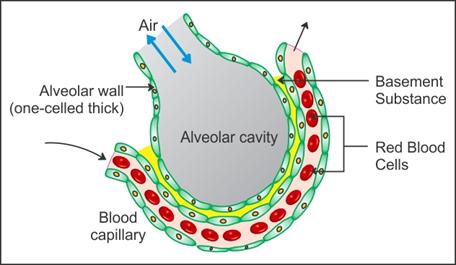
Q96. What are the factors which interfere with the formation of
oxyhaemoglobin?
Solution
Factors which interfere with the formation of haemoglobin are
Partial
pressure of CO2
Concentration
of hydrogen ions
Temperature
Q97. Name the respiratory organs of insects.
Solution
Tracheal tubes
Q98. Write the term for the additional volume of air which a person can forcibly
inspire?
Solution
Inspiratory reserve volume (IRV)
Q99. Distinguish between vital capacity and total lung capacity.
Solution
Vital Capacity
Total Lung Capacity
It
is the maximum volume of air a person can breathe in after forced
expiration.
It
is the total volume of air accommodated in the lungs at the end of
forced inspiration.
It
includes expiratory reserve volume, tidal volume and inspiratory
reserve volume.
It
includes the residual volume and the vital capacity (ERV + TV + IRV)
Q100. State the significance of the larynx.
Solution
The larynx is responsible for sound production.
Q101. Mention the two factors which can affect the rate of diffusion of oxygen and carbon dioxide during respiration.
Solution
The two factors which can affect the rate of diffusion of oxygen and carbon dioxide during respiration are as follows:
Solubility of gases
Thickness of the membranes involved in diffusion
Q102. Write the respiratory organs of the following organisms:
Tadpole
larvae
Shark
Planaria
Cockroach
Solution
Tadpole
larva - Gills
Shark
- Gills
Planaria
- Body surface
Cockroach
- Tracheal tubes
Q103. Oxygen binds to haemoglobin at the lung surface and dissociates at the tissues. Justify.
Solution
For the formation of oxyhaemoglobin, the factors required such as high pO2, low pCO2, low concentration of H+ ions and low temperature are maintained in the alveoli. Hence, the binding of oxygen with haemoglobin at lung surfaces is faster.
Low pO2, high pCO2, high H+ ion concentration and high temperature are the factors found in tissues which always favour the dissociation of oxygen.
Q104. Where is carbonic anhydrase found? Write the reaction it catalyses.
Solution
Carbonic anhydrase is found in RBCs. It catalyses the following reaction:


Q105. State the primary site of exchange of gases in lungs.
Solution
Alveoli
Q106. What is fibrosis and how is it caused?
Solution
Fibrosis is the uncontrolled proliferation of fibrous tissue which causes serious lung damage. Long exposure to dust particles weakens the defence mechanism of the body causing fibrosis.
Q107. What is residual volume? What is its significance?
Solution
Residual volume is the volume of air remaining in the lungs even after
forcible expiration.
By adding a few respiratory volumes, pulmonary capacities can be
derived which help in clinical diagnosis.




Comments
Post a Comment